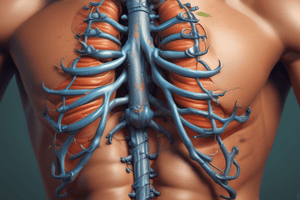Podcast
Questions and Answers
What is the primary function of kedging?
What is the primary function of kedging?
- To prevent swinging in a confined area
- To move the boat using the anchor (correct)
- To secure the vessel in strong winds
- To increase the holding power of the anchor
Which situation would most likely require the use of multiple anchors?
Which situation would most likely require the use of multiple anchors?
- When the anchor is not holding due to tide changes
- In confined anchorages to prevent swinging (correct)
- When sailing in open water
- While navigating through a storm
What might prevent an anchor from holding properly?
What might prevent an anchor from holding properly?
- Sandy or muddy bottoms
- A well-set primary anchor
- A steady wind coming from the stern
- Foul rode or bottom obstacles like boulders (correct)
What is the purpose of a sea anchor?
What is the purpose of a sea anchor?
What is a primary reason for setting the bow or stern anchor during difficult conditions?
What is a primary reason for setting the bow or stern anchor during difficult conditions?
Which type of anchoring technique could be utilized for precise maneuvering in tight spaces?
Which type of anchoring technique could be utilized for precise maneuvering in tight spaces?
What is a notable characteristic of claw-type anchors?
What is a notable characteristic of claw-type anchors?
In what situation do claw-type anchors generally struggle?
In what situation do claw-type anchors generally struggle?
What is the first step in calculating the anchor scope?
What is the first step in calculating the anchor scope?
How does catenary shape affect anchor performance?
How does catenary shape affect anchor performance?
Which type of mechanism does the Pathfinder windlass use?
Which type of mechanism does the Pathfinder windlass use?
What is the ideal depth of water to achieve a scope ratio of 7 to 1 using a 21 fathom rode?
What is the ideal depth of water to achieve a scope ratio of 7 to 1 using a 21 fathom rode?
What type of vessels primarily use a capstan?
What type of vessels primarily use a capstan?
What is the primary function of a Fisherman's anchor?
What is the primary function of a Fisherman's anchor?
What is a common disadvantage of claw-type anchors?
What is a common disadvantage of claw-type anchors?
What feature distinguishes the Danforth anchor from other types?
What feature distinguishes the Danforth anchor from other types?
How does the CQR/Plough anchor adjust to changes in direction?
How does the CQR/Plough anchor adjust to changes in direction?
Which type of anchor is considered the least effective in terms of holding power to weight ratio?
Which type of anchor is considered the least effective in terms of holding power to weight ratio?
What is a defining characteristic of heavy weight anchors?
What is a defining characteristic of heavy weight anchors?
Which conditions are important when selecting an anchor?
Which conditions are important when selecting an anchor?
What major drawback does a Fisherman's anchor have?
What major drawback does a Fisherman's anchor have?
Which type of anchor is described as generally good in all bottoms but not exceptional in any?
Which type of anchor is described as generally good in all bottoms but not exceptional in any?
Flashcards are hidden until you start studying
Study Notes
Anchors and Anchoring
- Anchoring protects boats from storms, offers crew rest, and is essential when dock space is unavailable.
- An anchor is crucial for maintaining vessel stability in case of engine failure.
Selecting an Anchor
- Consider water depth and bottom type (ideal substrates: clay, sand, mud; worst: rock, boulders, weeds).
- Take into account wind protection, prevailing currents, tides, and available room to swing in the anchorage.
Anchor Principles
- Two anchor categories:
- Heavy weights for stationary objects (e.g., navigation buoys).
- Anchors that dig into the seabed, combining weight and digging capability.
Types of Anchors
-
Fisherman’s Anchor:
- Non-burying with one arm penetrating the seabed; effective in rocky environments but has low holding power compared to modern designs.
- Prone to fouling the cable during tides.
-
Danforth Anchor:
- Features hinged stock that allows flukes to orient properly; excellent holding power once set.
- Lightweight and compact, facilitating storage and retrieval.
-
CQR/Plough Anchor:
- Versatile, performing well in various bottoms but not exceptionally in any.
- Hinged shank allows it to turn with changing conditions, enhancing holding capability.
Issues with Anchors
- Common failure scenarios include not enough scope, fouled rode, and unsuitable bottom conditions (e.g., boulders, weeds).
Kedging Technique
- Kedging utilizes the anchor to physically move the boat; involves rigging the anchor on a line and using a ship's boat to reposition it.
- Useful for maneuvering in tight areas or when there is no wind.
Using Multiple Anchors
- Bow and stern anchors prevent swinging in confined spaces.
- Two bow anchors are effective in tidal areas.
Sea Anchors
- Deployed during storms to direct the bow or stern into the wind/waves, reducing drift.
Bruce/Claw Anchor
- Sets quickly in most seabeds and aligns with force changes instead of breaking out.
- Challenges include poor performance in weedy bottoms and low holding power to weight ratio.
Capstans and Windlasses
- Capstans: traditional devices allowing crew to operate the anchor.
- Windlasses: mechanisms that include pawl-rack systems (e.g., Pathfinder) or gear systems for effective retrieval (e.g., Playfair).
Scope and Catenary
- Scope is defined as the ratio of anchor rode length to water depth; aim for a scope ratio of at least 3:1 for stability.
- An anchor rode forms a catenary, which reduces shock loads and helps maintain anchor position; proper sag in the rode is beneficial for holding power.
Studying That Suits You
Use AI to generate personalized quizzes and flashcards to suit your learning preferences.




